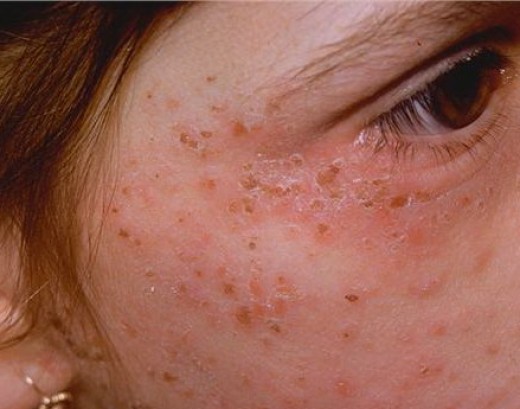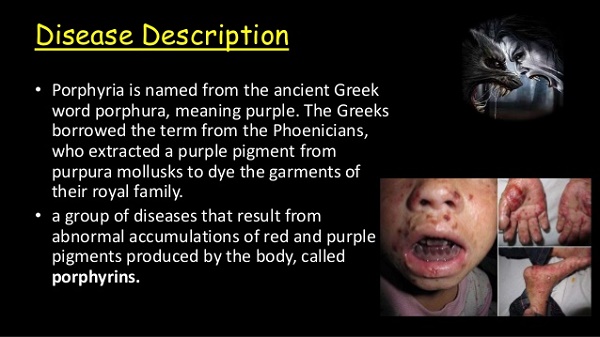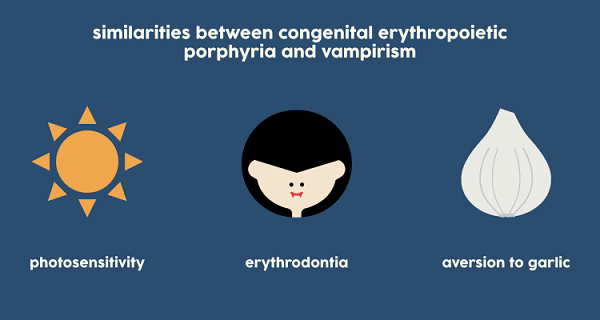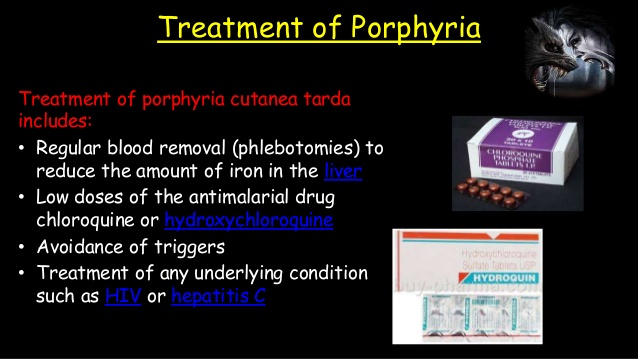And this explains, that those supernatural, blood drinking ‘vampires’ from the werewolf – vampire folklores of the 20th century, were perhaps humans suffering from a rare genetic disorder – Porphyria.
Porphyria comes from the word ‘Porphura’ meaning Purple pigment. So, how this disease is related to the purple pigment and more so, why is it known as the Vampire disease?
Porphyria is related to Porphyrins – a chemical produced by Healthy Human body, that is somewhat purple in color. And the absence of this, leads to the dreaded vampire disease. 
The 20th century vampires that are depicted in movies are seen to fear sunlight, they have abnormal growth of body hair, highly repelling to garlic and of course, they crave for human blood. Well, if not all, there have been some strange similarities between Porphyria symptoms and few vampire traits we have heard about. And thus, the name Vampire Disease.
Porphyria had always been there; however, for years it was wrongly confused with some liver disorder during its initial stages. It was only around 1871 that the relation of Porphyrin with this syndrome came to light. Thereafter, many clinical researches brought about different forms or types of Porphyria syndrome, and the research still continues.
Unfortunately, the ultimate cure for this disease still does not exist. However, early identification and diagnosis can help to control its adverse effects to a great extent.
What exactly is porphyria and the reasons behind it?
Porphyria is related to disrupted heme production in body. Heme is produced in the bone marrow and liver. It is one of the components of hemoglobin that gives blood its red color. Heme also carries oxygen from lungs to different parts of the body. In liver, it helps to break down hormones, drugs and contributes in the normal functioning of the organ.
Eight different enzymes produce Porphyrin, which then forms heme when combined with iron. Any deficiency or abnormality in any of these enzymes, inhibits normal production of Porphyrin. Precursors are formed that do not develop into porphyrin. Any deficiency in any of the eight enzymes leads to different types of disorders; collectively known as Porphyria.
The deficiency of vital enzymes required for heme production is related to abnormal genes that we inherit; either from one, or both parents.
The deficiency of any of these enzymes relates to different types of porphyria as discussed in the following section.
Different forms of Porphyria:
Porphyria classification is based on two factors:
- The area that gets affected – Skin or Nervous System and Brain
- The area where heme precursors accumulate – Bone marrow or Liver
Porphyria that affects the skin is known as Cutaneous Porphyria and when brain or nervous system is affected, it is known as Acute Porphyria.
Again, when heme precursors accumulate in bone marrow, it is known as Erythropoietic Porphyria. If the same accumulates in liver it is known as hepatic. Further, based on the type of enzymes and the above mentioned factors, Porphyria has been classified into the following eight types:
Acute Porphyria are:
- Acute Intermittent Porphyria
- Variegate porphyria
- Hereditary CoproPorphyria
- ALA Dehydratase Porphyria
Cutaneous Porphyria are:
- X – Linked protoporphyria
- Congenital Erythropoietic Porphyria
- Porphyria Cutanea Tarda
- Erythropoietic Protoporphyria
Acute Intermittent Porphyria (AIP): Acute Intermittent Porphyria is caused by inheritance of single abnormal gene from one parent. This leads to a deficiency of porphobilinogen enzyme that affects heme metabolism.
Variegate Porphyria (VP): Variegate Porphyria is caused by autosomal, or a single faulty gene. The heterogeneous mutation of protoporphyrinogen oxidase(PPOX) gene results in deficient production of PPOX enzyme that forms too much porphyrin precursors causing the disease. It is also known as mixed hepatic porphyria and can show cutaneous symptoms as well.
Hereditary Coproporphyria (HCP): Hereditary Coproporphyria is an acute hepatic condition in which the enzyme, coproporphyrinogen is deficient. It is also autosomal disorder and can shows acute as well as cutaneous symptoms.
ALA Dehydratase Porphyria (ALADP): ALA Dehydratase Porphyria is also known as Doss Porphyria or Plumboporphyria. An autosomal recessive disorder involving deficient ALA dehydratase enzyme that is required for healthy heme synthesis.
X- Linked Protoporphyria (XP): X linked protoporphyria is an erythropoietic condition that greatly effects infant boys. It is brought about by ALAS2 gene mutation that synthesizes first enzyme required in heme synthesis pathway. The rarest of of types of porphyrias.
Congenital Erythropoietic Porphyria (CEP): It is also known as Gunther Disease after the name of Hans Gunther who discovered it. It is related to gene mutation on chromosome 10 that is responsible for Uroporphyrinogen III synthase. It is autosomal recessive disorder, that is abnormal gene inherited from both parents.
Porphyria Cutanea Tarda (PCT): Porphyria Cutanea Tarda is the most common type of all porphyrias. It is caused by a deficient enzyme that is needed in the fifth stage of heme synthesis. Unlike other porphyria syndromes, PCT is an acquired condition that can be brought about by several different triggers as explained in later section.
Erythropoetic Protoporphyria (EPP): Erythropoetic Protoporphyria is a condition that is caused by deficiency in ferrochelatase enzyme. It is mostly an inherited disorder; however, it can be an acquired condition too.
Symptoms of Porphyria:
Porphyria symptoms have been classified into two sections based on the area it affects. You may find relevant symptoms below:
Symptoms of Acute Porphyria:
- Swelling of abdomen, followed by severe pain
- Patients suffer from either constipation or diarrhea. Vomiting is also experienced.
- Muscular pain, severe chest and back pain
- Numbness and sometimes tingling sensation
- Anxiety, restlessness and Insomnia
- Mental imbalance and paranoia
- A confused state of mind with recurrent hallucinations
- Elevated blood pressure levels
- Palpitations and seizures
- Red or brown or purplish urine

Symptoms of Cutaneous Porphyria:
- Excessive sensitivity to sunlight or artificial bright light causing patients to prefer darkness
- Redness of skin and swelling
- Severe blisters that are difficult to heal
- Fragile skin and itching
- Skin pigmentation; especially while blisters are healing
- Excessive and unwanted hair growth
- Red, brown or purplish urine
What can trigger Porphyria Symptoms?
Although, Porphyria Syndrome is a genetic disorder, the symptoms can be triggered and aggravated by the following discussed below. Besides, Porphyria Cutanea Tarda, that is an acquired syndrome has loads of triggering factors.
Porphyria Cutanea Tarda triggers:
- Excessive alcohol, smoking or estrogen
- More than usual iron in body
- Hepatitis C for prolonged period
- HIV conditions
- Genes that make the body absorb too much iron, leading to iron overload or poisoning
- Besides, alcohol, smoking, some hormones, stress and irregular diets can trigger any form of porphyria symptoms
Porphyria – Diagnosis
Porphyria is a difficult disease to diagnose, as most of its symptoms; such as diarrhea, vomiting, fever etc., can be easily confused with some minor abdominal troubles. However, three initial tests can determine if the patient is suffering from porphyria or not.
These tests include:
- Blood test
- Urine test
- Stool test
In addition to these, there can be number of other tests such as genetic analysis to determine Porphyria Syndrome.
Elevated levels of porphyrin or porphyrin precursors detected in blood, stool and urine determines Porphyria. Gene mutation can be diagnosed from DNA testing of blood samples.
Prophyria – Treatment:
As mentioned earlier, Porphyria cannot be completely cured; the treatment lies in reducing the severity of symptoms and discomfort it causes.
Treatment for Acute Porphyria:
All types of Acute Porphyria involve heme or glucose loading. It is a procedure where a patient receives glucose intravenously or by mouth. Heme is more effective than glucose.
In rarest of cases, this type of porphyria may require Liver Transplantation. The procedure involves removing dysfunctional liver or a part of it with a donor liver that is healthy. However, this is the last resolve and very rarely performed.
Treatment for Porphyria Cutanea Tarda:
The first approach for PCT treatment involves the elimination of all its triggers. The second approach involves the introduction of low dose hydroxychloroquine tablets that reduce and control development of precursors in liver.
Treatment for Erythropoietic Protoporphyria:
Beta carotene or Cysteine is prescribed that helps to improve sunlight tolerance. Hepatitis A and B vaccines are also suggested to reduce protoporphyria liver failures. Bone marrow transplantations can be adopted to treat disturbed heme synthesis in the marrow. However, this is again a last resolve and there have been cases where treatment was very close to total cure.
Treatment for Congenital Erythropoietic Porphyria (CEP):
Spleen surgery and blood transfusion are two methods of treatment for CEP. Blood transfusion, where healthy blood is induced into the body through intravenous procedures, treats severe anemia.
Phlebotomy: A procedure that involves removal of minute amount of blood from your veins. This procedure reduces iron and thus precursors. This is a repetitive procedure that needs to be carried out at short intervals.
Vitamin D: As porphyria patients avoid sunlight, it is evident that they lack Vitamin D, and this may lead to severe disorders. Thus, your doctor will always prescribe Vitamin D supplements while treating Porphyria.
Fight Porphyria with essential lifestyle changes:
Living with porphyria could become easier and nearly close to normal, if essential modifications can be brought about. Let us see a few of them:
- Patients with this syndrome need to identify things that trigger their symptoms
- Completely abstaining from alcohol and smoke is more than compulsory
- Fasting and dieting could aggravate symptoms and therefore need to be avoided
- Take any slight infection or skin rash seriously and consult a doctor immediately
- Emotional stress can make things difficult.
Apart from treatment and changes in life style, porphyria patients do require a lot of support and patience shown by their near and dear ones or for that matter, the whole society as a whole.
Later stages of Porphyria lead to an extremely dangerous condition where parts of their ears and nose are receded or eaten away; leading to horrible distortion. Therefore, it becomes extremely difficult for patients and increased emotional stress is very likely in such circumstances, This in turn, worsens the condition and proves fatal.
Therefore, porphyria cases need to have an early diagnosis to eliminate chances of such severe conditions in the first place. And if unfortunately a person reaches to such unfortunate stages of porphyria, care and support can help them to fight.


